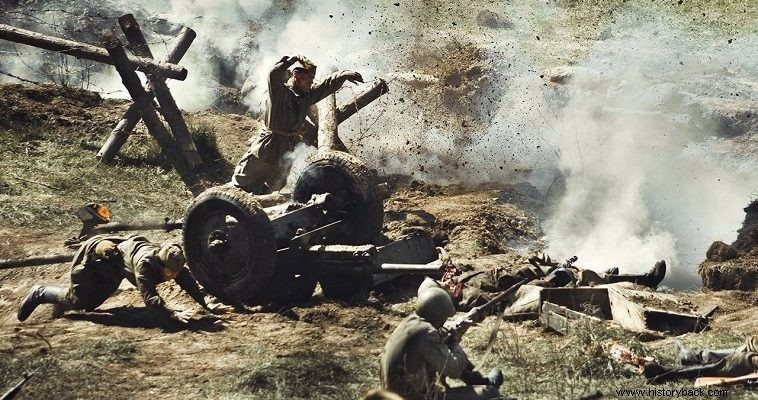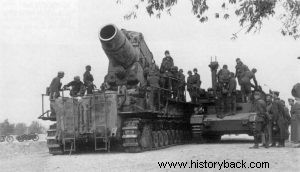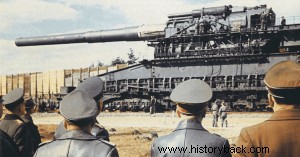
The siege of Sevastopol is the most important and longest siege operation during World War II. In the six months or so of the siege of Sevastopol, which escalated into Operation Störfang (loosely translated as the fishing of Oxyrhynchus), the Germans had to call upon their great general, Erich von Manstein, an elite army them, the 11th and almost all of the heavy guns they had, to put down the fanatical resistance of the Soviets.
Sevastopol is located at the southwestern tip of the Crimean peninsula. It was an ancient Greek colony. To the west of the current city, the city of Hersonissos Herakleotiki was built in the 8th century BC. For centuries it remained under Byzantine control, included in the Theme of Chersona, only to then fall into the hands of the Tatars.
The city, until October 1941, did not have serious fortifications to cover it from land. Only its port was protected by coastal artillery and fortifications. The strongest fortress of the port was the notorious Maxim Gorgi . This coastal fort had begun to be built in 1912.
Later another fort (Maxim Gorgi II) was built covering the southern approaches to the port. The two forts were equipped with 305 mm naval guns. with a maximum range of 42 km. The guns were mounted in towers with a maximum armor of 406 mm. The forts covered rows of machine guns, anti-aircraft guns and infantry positions.
The northern fort belonged to the 30th Naval Artillery and the southern to the 35th. The main role in the battle was played by the 30th Artillery, whose garrison became a real holocaust. There were 10 other coastal artillery around the city covering it from the sea.
However from land the city was uncovered. Only in the face of the German danger was it decided to rapidly fortify it. Three lines of defense were created, the outer, the main and the inner. When the fortification work was completed, 82 fortifications had been constructed from reinforced concrete and 220 fortifications from earth and tree trunks.
33 km of anti-tank trenches had been excavated and 56 km of barbed wire belts had been laid. Minefields with thousands of anti-tank and anti-personnel mines had also been laid. The soul of this effort proved to be the commander of the Independent Coastal Defense Army, Major General Ivan Petrov.
On September 25 the German 11th Army invaded the Crimea and pressured the Soviets. Gradually only Sevastopol was still under their control. Manstein planned to attack Sevastopol immediately, so as not to give the Soviets time to organize their defenses, but severe bad weather that broke out prevented him from doing so.
The Soviets took advantage of the time they were given and moved significant forces to Sevastopol. Thus it became possible to organize the defense perimeters in time, before the German attack. The German attack would be supported from the air by the 8th Air Corps of Wolfram von Richthofen (cousin of the great ace of World War I) and from the sea by an Italian naval squadron under Admiral Francesco Mibelli.
The weather did not improve until mid-December and a first attempt on the town was made on 17 December 1941, but was easily repulsed by the defenders, who were now greatly strengthened. It was evident that other means were needed to bring about the downfall of the fortified city.
The total strength of the garrison now reached 55,000 men. Later the garrison was further strengthened and in the final phase of the siege its strength exceeded 100,000 men and women. But most of them, even in the rifle divisions, came from the navy.
Meanwhile, the Soviets simultaneously launched a massive counterattack through Kerch, but were soundly defeated. Despite his great victory, Manstein was reinforced with the strongest German arsenal had to offer. The 11th Army was reinforced with two artillery divisions, so that on the eve of the battle it could line up 785 German and 112 Romanian guns of all calibers.
Of course, among this volume of artillery, the "stars" of the 833rd Heavy Brigade, equipped with the "Thor" super mortars, stood out. and "Odin" of 600mm, Karl type which could put a concrete-piercing projectile weighing 2.4 tons. at a distance of up to 4 km. and the 672nd Artillery Squadron, with the "Dora" supergun , caliber 800mm. "Dora" was capable of putting an armor-piercing projectile weighing 7.1 tons. at a distance of up to 37 km or an explosive weighing 4.8 tons at a distance of up to 47 km.
But there were other representatives of these giants, equally impressive. These were guns, mortars and howitzers of 420, 355, 305, 283, 150 and 105mm. They were also provided with a total of 126 rocket launchers.
In the infantry the situation was less bright for von Manstein. His divisions were greatly strained by the continuous struggle of six almost continuous months. The infantry battalions did not have a strength of more than 350 men. Manstein's strongest corps, the LIV Army Corps (SS), had just 15,000 combat troops in its four divisions. As far as armored vehicles were concerned, 65 Stug III assault guns were granted.
The army was also reinforced with additional Engineer battalions. In the final battle it had eight Engineer Assault battalions. Each Engineer battalion had a strength of about 400 men, while it was equipped with 10-12 flamethrowers, explosive charges (3,000 kg per battalion), 2,200 grenades, 500 smoke grenades and remote-controlled "Goliath" explosives placement chariots.
Bombing
The general attack was set for June 7. But the Luftwaffe and the artillery would start two days earlier, paving the way. Manstein had placed the LIV SS on the opposite northern side of the Soviet perimeter and the XXX SS on the south. The Romanian Mountain Army Corps (OSS) was positioned in the center with the mission of engaging the Soviet forces in front of them. The center of gravity of the attack was in the north, where the LIV SS had the difficult task of crossing the small Belbek River, which ran along the Soviet defensive position, under enemy fire.
On June 2 the defensive positions, the entire city was covered in smoke, fire and death. Electrical installations, the port, the ships, the forts were being bombarded fiercely. On the first day alone the Luftwaffe flew 723 sorties and dropped 525 tons of bombs with the single loss of a Stuka. Manstein would not throw his infantry into battle before air and artillery inflicted mortal wounds on the Soviet defenses.
Soon the German artillery joined the macabre dance, crushing the Russian positions. The Germans gained absolute air superiority and their aircraft flew up to 2,000 sorties per day during these five days of intensive bombing. But the German artillery also hit the Soviet positions 24 hours a day without mercy.
Manstein knew that the Soviets had created a fortified site of incredible depth and strength. The total length of the trenches they had dug alone exceeded 350 km. As for the Dora supercannon its projectiles destroyed everything where they fell. This cannon fired three rounds an hour, manned by 4,120 men!
Another unpleasant surprise for the Soviets was the famous German 88mm guns. Manstein commissioned the 88mm anti-aircraft guns. the destruction of Soviet active canopies by direct fire. Only the 88mm guns. they fired 181,787 missiles against Soviet ground positions during the final battle for Sevastopol.
The meticulous Manstein observed the enemy's three defensive zones, each of which extended to considerable depth. The first one was 3km deep. and four lines of trenches, with artillery pieces of concrete or tree trunks, at regular intervals. Each line of trenches was protected by belts of barbed wire and minefields.
The second zone was 1.5 km deep. but it included, especially in the northern sector of the front, a series of forts, Stalin, Molotov, Volga, Siberia, GPU, Cheka, Uralia and the famous Maxim Gorgi I, with its 4 305mm naval guns. in two twin towers. The third defensive zone surrounded the city itself.
Infantry supply
The night of June 6-7 was hot and muggy. The Germans waited sweating in the front line trenches ready to rush. As the artillery bombardment continued the first German assault groups left their trenches and was moving towards the enemy's first line of defense. The time was 03.50.
In the northern sector, where the center of gravity of the attack was, the assault pioneers began to open zones between the enemy minefields in the valley of Belbek and in the gorge of Qamishli. The assault groups of the infantry passed through these zones, accompanied by assault guns. Although the German artillery had done a good job, the Soviet defenders of the half-destroyed front-line trenches were not stopping the fight except when a grenade exploded in front of them.
Even under these conditions, the Germans advanced and reached the Stalin fortress. A first attempt against him failed. The heavy German artillery then concentrated its fire on the fort, reducing it to a pile of rubble.
Through the ruins, however, the Soviets were jumping out from everywhere and fighting furiously. The garrison of the fort consisted of members of the Communist Youth and members of the Soviet Communist Party. In one of the fort's machine guns that had taken a direct hit from heavy artillery and was blown up, the Germans were able to count at least 30 enemy dead around.
Nevertheless, the ten or so survivors continued to fight, creating a makeshift fortification with the corpses of their comrades. The German pioneers managed to get close and set fire to the area with their flamethrowers. Nevertheless the survivors continued to put. It wasn't until late in the afternoon that the Germans managed to take control of the machine gun, there were only four, badly wounded, Soviets alive . A political commissioner who was with them caught up and killed himself.
Indicative of the tension is the fact that all the officers of the two battalions of the German 16th Infantry Regiment (SP) that attacked Fort Stalin were killed or wounded. A lieutenant from the division staff was sent to take command of both battalions!
With great sacrifices, the Germans nevertheless managed to beat the enemy's first defense line and penetrate, in some places, the second. On June 17, the attack continued in the northern sector. This time the Germans advanced two 355mm howitzers. at a distance of only 4 km. from the Soviet positions, so as to neutralize the guns of Maxim Gorgi I.
After the third volley, however, the artillery observers reported with dismay that the howitzer shells had not caused the slightest damage to the fort's armored gun towers. The commander of the howitzer artillery then ordered the use of the special piercing-explosive "Wrestling" projectiles.
The 3.6m long and weighing 1,000 kg this projectile was designed to explode after first having succeeded in piercing the target. With only two volleys the armored towers of the fort were destroyed. The Maxim Gorgi fell silent, but its guard, consisting of 1,000 men and women, continued to repel every attempt by the Germans to penetrate its underground apartments.
The 24th Engineer Battalion was tasked with clearing the underground galleries. Using huge amounts of explosives, the German pioneers succeeded in the first phase in opening a hole in the surface of the fort. The fortified complex extended three stories deep into the ground, 300 m long and 40 m wide. The main complex was divided into several smaller ones, with double steel doors.
It also had an autonomous electricity supply system, warehouses, and even a hospital. Each door had to be blown up in turn. The Soviets wore gas masks and fought from special hatches that were everywhere. However, the Germans proceeded methodically, step by step towards the command center of the fort.
The last message of the defenders reached the Soviet headquarters:“We have 22 left. We are preparing to blow up. This is our last message. Goodbye". The fort's command center was blown up by its defenders. Of the 1,000 defenders, the Germans took only 40 prisoners, and those seriously wounded.
Easily the Germans captured Molotov, Cheka and GPU fortresses, Siberia, Urals and Volga. In the center also German and Romanian mountain units managed to break through the Soviet defense and closely supported by the artillery, to reach almost to Severnaya Bay.
In the southern sector the German attack took place on June 11, as planned. With hard-fought German divisions managed to capture a series of fortified hills that covered the city from the south. Sevastopol now lay before them. After the fall of the two main lines of defense, the Soviet defense began to collapse.
Nevertheless the Soviet leadership still sent a brigade into the city, on the night of June 26, only to sacrifice itself needlessly, in a now lost cause . On the night of the 27th, the Germans managed to raft battle groups from one side of Severnaya Bay to the other, effectively encircling the last islands of Soviet resistance.
In the face of this development, only tradition remained. However, there were examples of fanaticism, such as a commissar blowing up an underground bunker just before the Germans entered, killing around 1,000 women and children who had taken refuge there. The Soviet Navy tried to remove the head of the garrison from the doomed city and succeeded.
By July 3 the guns had fallen silent in the once beautiful coastal state. The 11th Army captured 97,000 prisoners. Soviet dead exceeded 18,000. German losses were also heavy. The dead and missing – apparently dead whose bodies were simply not found – exceeded 6,000 and the wounded 18,000.
Romanian losses reached 2,500 dead, missing and wounded. The loss rate is very high, considering that Manstein's forces were just over 60,000 men.
The Battle of Sebastopol also marked the end of the Crimean War. The Germans held the peninsula until 1944, when they were driven out by the Soviets.
https://www.youtube.com/watch?v=RFdGE3zBRSI

German Karl type assault gun.

Hitler inspects a supergun, the 800mm Gustav or Dora.
